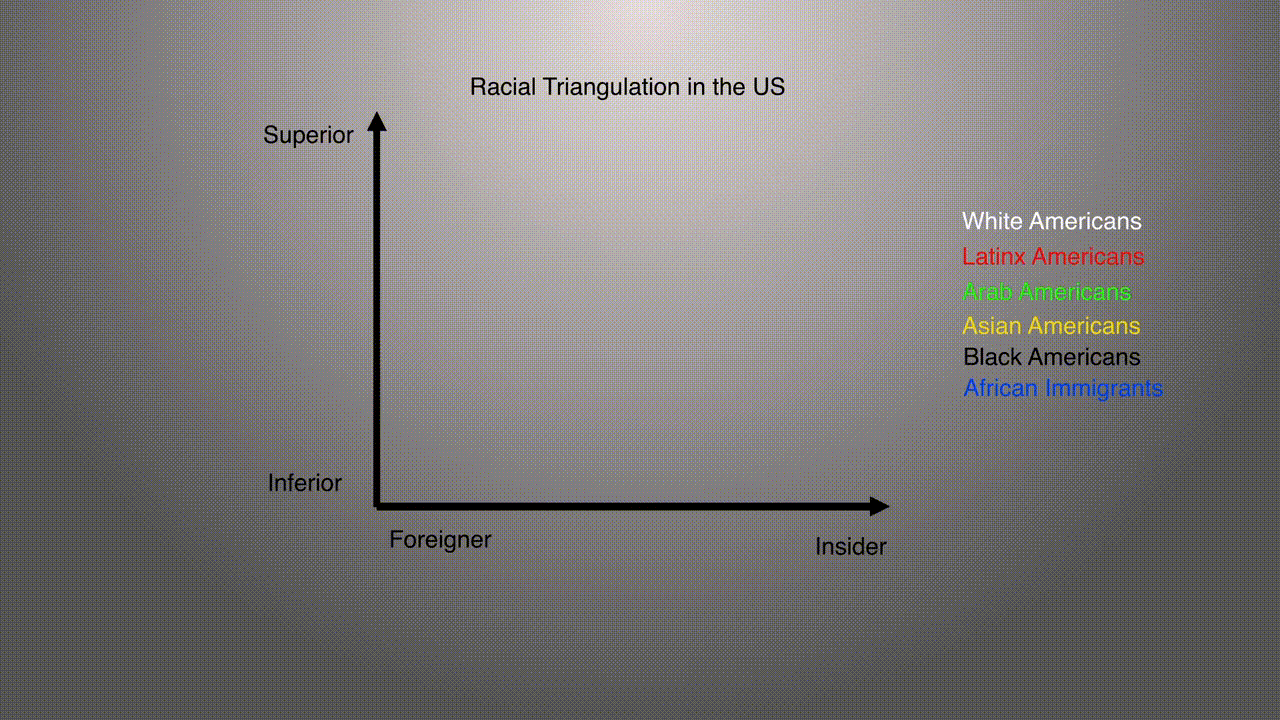
Racial Triangulation
After 9/11, some argue that Arabs have taken Black Americans’ spot on America’s hot seat of focused harassment and marginalization, or as Moustafa Bayoumi, an English professor put it, “Arab is the new Black.” In an interview on NY Public Radio, Bayoumi talks about how a new sense of a “dangerous infiltration” in America has led to the development of an “Islamophobic industry.” This has meant that immigrant Muslims, who have previously fared average to above average in the American economy, now face problems that have plagued the African American community for decades.
Although there appears to be a clear lowest tier to an seemingly linear racial hierarchy in America, Claire Jean Kim, a sociologist, asserts there is a more complex system of interactions between minority groups and White America. Specifically, Kim analyzed relationships between Whites, Asian Americans, and Blacks, and coined the term racial triangulation to describe the interactions. The structure involves two types of relations: civic ostracization and relative valorization. Asian Americans receive both from Whites, who propagate the idea that they are “model minorities” and valorize them as hard-working and studious while ostracizing them as foreign and socially unlikable. This is used as a tool to ostracize Blacks by regarding them as, in turn, lazy, uneducated, unambitious, and far from the “model minority.” Both of these processes, in turn, work to bolster White supremacy and privilege. (View Images Below)
This triangulation can be extrapolated to many other demographic groups within the US racial hierarchy, such as white immigrant Muslims, Black Muslims, and white convert Muslims. In this example, racial authority and authenticity are also interesting measures to observe triangulation. According to Pew, 58% of U.S. Muslim adults are immigrants, while the remaining 42% consist of descendents of immigrants, converts (many of whom are black), and descendents of converts. Although each group “exhibits a very similar levels of religious observance”, as reported by Pew, there is still a disconnect between the groups at a socio-economic level. Immigrant Muslims from the Arab world and South Asia are often seen as more authentic both inside and outside of the Muslim community, they are faring far better in attaining higher education and earning higher paying jobs, and some can choose keep their religion private if they look “white” enough (although the majority of immigrant Muslims appear uninterested in “passing” as white). This immigrant group, similar to Asian Americans, are valorized by White Americans to further ostracize other minorities, as talked about before.
With the ascribed authenticity, immigrants are given the authority to determine the authority and authenticity of other Muslim groups. This is where we see the start of a triangulation within the Muslim community. Sylvia Chan-Malik, a leading scholar of race and ethnic studies, asserts in “Common Cause: On the Black-Immigrant Debate and Constructing the Muslim American” that there have been various cases of ethnic particularism by immigrant Muslim communities who have shunned Black Americans from entering mosques, participating in other religious activities, and from being in leadership positions. This decreases both their apparent authenticity and authority in the Muslim American community. White American converts face similar ostracization, since their authenticity is also questioned. There is no method to systematically ostracize white converts, however, due to equal economic access, as opposed to Blacks. Furthermore, White American converts have the ability to take their own leadership positions because of the existing power structure in America—take Hamza Yusuf, for example. Our class found that the triangulation begins to take shape with Muslim immigrants holding both authenticity and authority, while White American converts have far less authenticity and Black American Muslims have far less authority.
Sources:
“Moustafa Bayoumi: 'Arab is the New Black'” by The Leonard Lopate Show, WNYC
“The Racial Triangulation of Asian Americans” by Claire Jean Kim



